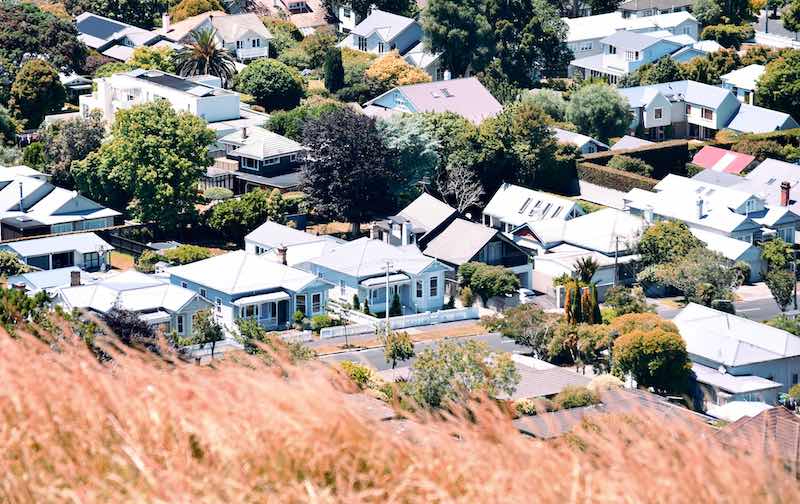The median house price has declined from NZD $925,000 to $875,000 Real Estate Institute of New Zealand (REINZ) figures show.
In Auckland, prices have declined 10% since November - from $1.3 million to $1.17 million.
Changes to zoning restrictions in Auckland now allows developers to build up to six storeys across much of the city as part of a Government plan to increase high-density and affordable housing.
This is against a backdrop of house prices increasing 45% in the two years to December 2021.
Sales volumes are also down sharply - led by Auckland down 34.5% - at 30.1% nationally year-on-year.
REINZ chief executive Jen Baird said the country is now in the trough phase of the property price cycle.
"We’re now in the phase of the property cycle where demand has weakened, sale counts are down but prices remain high," Ms Baird said.
"We’re seeing a slowdown in activity, there is more stock staying on the market for longer, and while annual price growth is more moderate, the month-on-month trend shows a fall in median prices."
Last week at the New Zealand Parliament's Finance and Expenditure select committee, Reserve Bank of New Zealand (RBNZ) Governor Adrian Orr said house prices are up to 20% above "sustainable" levels.
"A steady adjustment of prices towards more sustainable levels based on fundamental demand and supply factors remains desirable for the stability of the financial system," the RBNZ's May Financial Stability Report read.
Will Australia follow?
Many economists and commentators believe the Australian property market will at least flatline, especially in Sydney and Melbourne.
Prior to the RBA cash rate hike in May, Sydney and Melbourne property prices were already flatlining.
New South Wales and Victoria account for around two thirds of the value of Australia's $9.9 trillion in housing stock.
In terms of further falls, Westpac chief executive Peter King believes house prices could decline 10 to 15% over the next two years.
AMP chief economist Shane Oliver and HSBC chief economist Paul Bloxham forecast similar.
However Propertyology head of research Simon Pressley noted Australia's economic strength could keep house prices elevated.
"Australia is fast approaching full employment for the first time in decades, wage growth prospects are rising with it, infrastructure investment is a record high, there's lots of industry stimulus, and households have more cash squirrelled away than ever. Why the negativity?" Mr Pressley told Savings.com.au in November.
RBA modelling shows Australian households are generally well-covered to weather any rate rises, with the average owner occupier on a variable loan ahead on their repayments by 21 months.
If interest rates rose two percentage points, this buffer would decrease to 19 months - pre-pandemic it was 10 months.
Such interest rate rises could also potentially decrease house prices by 15% - mortgage stress would also double from 10% to 20% of homeowners.
Notable economic differences between New Zealand and Australia
Despite being a fifth of the size in terms of population, New Zealand often leads Australia by at least a few months in a few key economic areas.
Inflation and unemployment
New Zealand's headline annual inflation neared 5% in September 2021 - Australia's at the time was 3%.
It hit 6.9% in March this year when Australia's was 5.1%.
New Zealand's unemployment rate is 3.2% while Australia's is 4.0%.
Cash rate
The RBNZ began increasing its official cash rate (OCR) in October last year while Australia's target sat at 0.10%.
The RBA hiked in May this year to 0.35%, while New Zealand's OCR is now 1.50% following three 25 basis point hikes and one 50 basis point increase.
Ms Baird said the RBNZ's changes to the OCR pulled some heat out of the market.
"Increases to the OCR, most recently by 0.5% in April, have further impacted affordability, and with the cost to own increasing, property may seem less attractive," she said.
"Fear of overpaying has overtaken fear of missing out, as potential buyers take the time to consider the financial environment and their increased options on the market."
Prudential and lending policies
Unlike Australia's RBA, the RBNZ also acts as prudential regulator and the New Zealand Government expanded the central bank's remit to promote sustainable housing price growth.
The RBNZ tightened some macroprudential policies in March 2021, including closing some capital gains tax benefits, the amount of low-deposit home loans allowable, and the amount of investor lending allowable.
This was a full seven months before APRA, Australia's prudential regulator, raised the serviceability buffer from 2.5% to 3.0%.
"We have also come to see that it is important to have a fuller suite of macroprudential tools, which help manage both the risks to the financial system from a fall in house prices and the risks to households being unable to service their debt," said Christian Hawkesby, RBNZ's Deputy Governor.
"Our loan-to-value ratio requirements for mortgage lending have also limited the accumulation of highly leveraged loans, building economic and financial resilience."
Vulnerable home buyers
The RBNZ's Financial Stability Report said new home buyers will be most vulnerable to interest rate rises.
"They have repaid less principal, experienced smaller equity gains, and in recent years will have had their serviceability assessed at lower interest rates," the report read.
"Over half of the current stock of fixed-rate lending is due for refixing this year, with some borrowers facing potentially large increases in their debt servicing costs, particularly those who have borrowed at elevated DTI [debt to income] ratios.
"Rising living costs, which are reducing real household disposable income, may also create stress for mortgage borrowers."
In Australia, first home buyers borrowing at or close to their limits will have weaker borrowing power as dwelling price declines are yet to match pace with interest rate rises.
This is why the RBA wants to "front load" its interest rate increases, according to Westpac chief economist Bill Evans.
"In the early stages it is 'safer' to move at a faster pace than in later stages when the build-up in rates will start to impact households," Mr Evans said.
Advertisement
Buying a home or looking to refinance? The table below features home loans with some of the lowest interest rates on the market for owner occupiers.
| Lender | Home Loan | Interest Rate | Comparison Rate* | Monthly Repayment | Repayment type | Rate Type | Offset | Redraw | Ongoing Fees | Upfront Fees | Max LVR | Lump Sum Repayment | Extra Repayments | Split Loan Option | Tags | Features | Link | Compare | Promoted Product | Disclosure |
|---|---|---|---|---|---|---|---|---|---|---|---|---|---|---|---|---|---|---|---|---|
5.54% p.a. | 5.58% p.a. | $2,852 | Principal & Interest | Variable | $0 | $530 | 90% |
| Promoted | Disclosure | ||||||||||
5.49% p.a. | 5.40% p.a. | $2,836 | Principal & Interest | Variable | $0 | $0 | 80% |
| Promoted | Disclosure | ||||||||||
5.64% p.a. | 5.89% p.a. | $2,883 | Principal & Interest | Variable | $250 | $250 | 60% |
| Promoted | Disclosure | ||||||||||
5.64% p.a. | 5.89% p.a. | $2,883 | Principal & Interest | Variable | $248 | $350 | 60% |
| Disclosure |
Image by Nick Sarvari on Unsplash

Ready, Set, Buy!
Learn everything you need to know about buying property – from choosing the right property and home loan, to the purchasing process, tips to save money and more!
With bonus Q&A sheet and Crossword!





.jpg)

 Denise Raward
Denise Raward
 Harry O'Sullivan
Harry O'Sullivan
 Bea Garcia
Bea Garcia
 William Jolly
William Jolly


